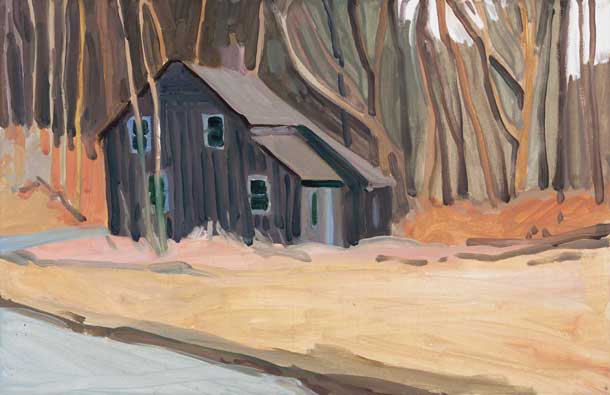
Elizabeth O’Reilly, Black House, Blairstown, Oil on Panel, 6 X 12 inches 2014 image courtesy of the George Billis Gallery
I am very pleased to have had the opportunity to interview Elizabeth O’Reilly by video skype and email and would like to thank Elizabeth for her generosity with her time and energies with this interview. Elizabeth O’Reilly shows at the George Billis Gallery in NYC, NY and her tenth solo show there is planned for October 2015.
Larry Groff: You studied to be a teacher in Ireland before you went to art school and moved to the United States. What led you to become a painter?
Elizabeth O’Reilly: Drawing and Painting were a constant in my life since I was a little girl. My mother died when I was three years old, and my father had already left for work in the US, so 8 of the 9 children were placed in State Schools in Dublin. The State Schools were basically orphanages, and we were placed there even though my father was alive. He stayed in the US until he retired. In the school there was a seamstress who made uniforms and all the clothing we needed. She said I would sit beside her while she was sewing and I would draw with pins on her pincushion. It drove her crazy. But that’s how far back my urge to draw was commented upon. Painting and drawing were the things I got attention for all the way through school. Praise was thin on the ground, so it meant a lot to be singled out for my artwork.
The State Schools were closed down when I was ten and one of my sisters and I were sent to a regular boarding school at that point. There was an art room and an art teacher, and that’s where I spent my free time. My dream was to go to art school. My portfolio was accepted and I got a place. There were only two art schools in Dublin, and maybe three in the entire country at that time, so it was a big deal to be accepted. Reality hit though and I knew I couldn’t attend as I had no money. Teacher Training college was completely subsidized, and I had the grades, so I had to settle for that. I was heart-broken. I graduated and taught at the elementary level in Dublin. I always took art classes at night and on the weekends. I studied watercolor, and drew onsite at various locations in Dublin, and made color and value notes, and painted the cityscapes in class from my notes and sketches.
I continued teaching and my boyfriend moved to the US in the mid 80’s in the last recession. I had the option of taking a career break, so that I could leave my job for up to five years and still have it back at the end of that time. I followed him to Brooklyn, and taught on the lower East Side for 3 years. That job got us our green cards, and eventually citizenship. I took a teaching job in a private school in Park Slope where I was living.
I took art classes at the Art Students League on Saturdays while teaching school Monday to Friday. I took a painting class at night at Brooklyn College in the Continuing Ed program, and decided to apply to the MFA Program, even though my undergraduate degree was in Education. My teacher there, Sam Gelber, was very supportive and said he would back me up. He knew I was serious about my painting. One professor dashed my hopes as I didn’t have the undergrad credits I needed, but I don’t know what inspired me to go to the art office to plead my case. I spoke with Joe Groell. For some reason, he chose to give me a chance. Last year I ran into him at an opening in the city, and I walked over to him and said, “I don’t know if you remember me but you helped me when I tried to get into the MFA Program at Brooklyn College. I didn’t have the credentials, but you supported me. You changed my life, and I wanted to say thank you.” He said, “I remember you. My wife and I had just been to Ireland. There was something about you….” And his voice trailed off.
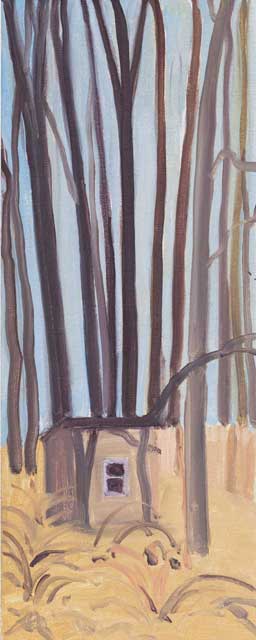
Winter Trees & Cabin
Oil on Panel 10 X 4 inches 2014
image courtesy of the artist and the George Billis Gallery
While I was talking to Joe Groell back in the art office Lois Dodd walked in, so I met her also. We chatted briefly, and she was also willing to give me a chance, and now I had three people backing me, and I was accepted into the program. That was my big break. It’s amazing what can happen when you show your face. That’s a big life lesson for me. If I had just mailed in my application I’m positive I wouldn’t have made the cut. That was 1990, twenty-five years after losing my first chance to go to art school.
A year into the program I gave up my teaching job and studied full-time,though I continued to teach art at the elementary school where I had been working. The US was a huge culture shock, but I got the opportunity that had slipped out of my hands in Ireland.
LG: You got your MFA from Brooklyn College in 1992. What was your experience in Graduate school and/or what were some important or memorable experiences you learned early on that helped make you the painter you are today?
Elizabeth O’Reilly: Brooklyn College changed my life. I had never had an art history class and was missing the background that the other students had, but I worked hard, and I did well. Everything was new, but I was eager. John Walker was teaching in the MFA program at the time. He was incredibly supportive of all the students. For the most part I painted from observation and I know I felt like a second-class citizen because of that, but John Walker supported all of us, regardless of whether we painted abstractly or figuratively. I won a prize at my final review that was an opportunity to co-teach a class with one of the professors. Lois is a very non-hierarchical person, and she didn’t intimidate the students in any way, so I asked her if I could co-teach with her. She agreed and thus began our long friendship that has endured for two decades. I co-taught a 2D design class with her. When I’m relaxed I learn more and so it was a good fit.
Lois would invite any grad students who wanted to paint the landscape to her place in Blairstown, NJ on the weekends. Several of us would go out there with her, and it was never a student/teacher set up. She has always enjoyed painting buddies. That continued after I graduated. As I’ve said, Lois is very non-hierarchical which is an impressive trait in a very hierarchical field. During grad school I started to paint large still-lifes. John Walker had ideas about how I could develop these and that really helped me to move forward. I then went through an abstract period. Bill Williams encouraged me to look into my own culture for subject matter, and I got very involved in painting abstractly from the burial mounds at Newgrange, a megalithic tomb in County Meath, in Ireland. That was a great experience. I did a lot of monoprints and large oil paintings based on those.
I graduated in ’92, and got a studio that summer in the Gowanus Canal area of Brooklyn which was a 20 minute walk from where I lived. It was a dark and unsafe neighborhood back then. I painted still lives in the studio but I continued to go to Blairstown with Lois, and before I knew it I was back painting the landscape again. I would say the time spent painting abstractly enriched my subsequent landscape paintings. At first I only painted the landscape with Lois in New Jersey, and on other painting trips to Vermont, Maine and Ireland, but one day I painted out the window of my studio, and another day I painted the alleyway behind my studio. Suddenly a whole new world of cityscapes opened up to me.
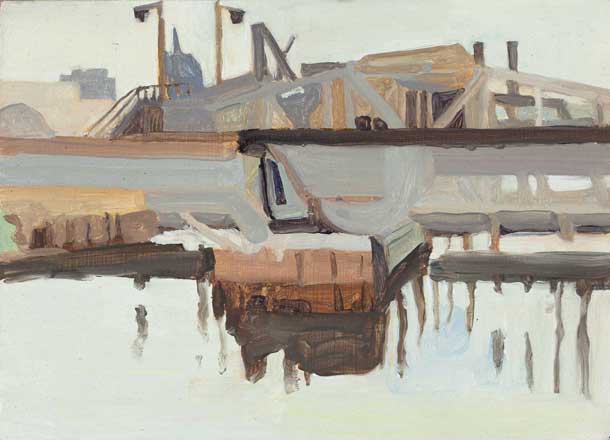
Newtown Creek, Oil on Aluminum 5 X 7 inches 2014 image courtesy of the artist and the George Billis Gallery
Prior to going to Brooklyn College I painted landscape and cityscapes in Ireland. My classes at the League were figure drawing and watercolor painting. I took color notes and drew out in the landscape. I drew all the time, and then used that information to paint indoors. That was great practice for honing my observational skills.
LG: Lois Dodd has been your mentor and good friend and in 2002 had a 2-person show with her at Swarthmore College. Can you tell us something about how her teaching and work has influenced you?
Elizabeth O’Reilly: Lois has indeed been a mentor and friend and important influence in many ways. She is an amazing painter. I am impressed by her painting practice. She is excellent at getting started. The world is full of excellent landscape painters, but Lois distinguishes particularly by her way of looking at the world. Her choice of subject matter is really very original and personal. She has great integrity, is smart, kind and generous. I learned more from her after grad school by seeing how she lives her life and how she fits painting into her day. She doesn’t get side-tracked the way I can. We have a lot in common, similar interests and similar politics and taste in food. That makes it easy for us to be around each other for long periods of time. There is trust, friendship and support. Lois likes to have a painting buddy. It’s always easier to start painting if there’s another painter around, though she is more disciplined than I am. I was fortunate to have Lois as a close friend for more than twenty years. We’ve had many painting trips together, from Vermont to Wyoming, Maryland to North Carolina. I think we had three painting trips to Ireland and I’ve been to her place in Cushing, Maine every summer since I graduated from Brooklyn College. She’s a very loyal friend. I don’t get out to Blairstown as often as I used to, but even if the weather is really cold we paint looking out her windows.
It’s been really helpful seeing how she chooses what she paints. On a day that I might consider not a painting day, she will paint patterns of raindrops or frost on her windowpane.
Lois and I were invited to have a two-person show at the List Gallery in Swarthmore College. Andrea Packard, the director, thought a student/mentor show would be a great idea. It was fun. We showed paintings from various painting trips we’d had together including Ireland. We talked about how we would look at the same subject and how different the paintings would look. Lois can find subject matter everywhere. That’s interesting. A friend says she makes a painting, takes one step in another direction and finds the next subject. We paint at the same pace so that makes things easy for us.
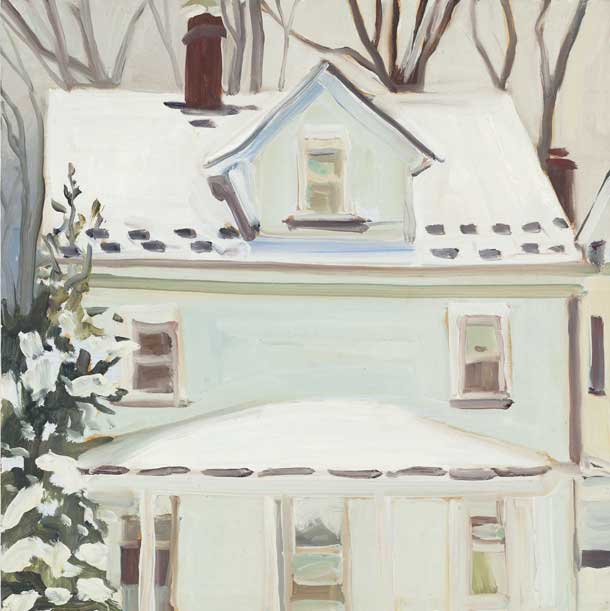
Winter Green, 10 X 10 inches Oil on Panel 2014 image courtesy of the artist and the George Billis Gallery
LG: In addition to Lois Dodd, I would think that the simplifications and abstractions from nature that Milton Avery, Fairfield Porter and Edward Hopper were involved with would interest you. What can you say about these painters in relation to your work?
Elizabeth O’Reilly: Milton Avery is someone I looked at a lot in Grad school. I’m very interested in simplification and abstraction from nature. It’s all abstraction really, an arrangement of shapes and colors on the rectangle. And the illusion of a 3D space on a 2D surface. But I need and want to look at something outside of myself. I need that visual stimulus. I’ve been painting cityscapes a lot and I often point out to students how Hopper paints windows, everyone is different. It helps students to really observe what they are seeing, not to just repeat the same window shape in each building. Fairfield Porter is a terrific painter too. I wish I had the confidence to paint large paintings the way he does. His figures and interiors are really inspiring.
LG: You said you need outside visual stimulation to get out of yourself … I find that a very interesting thing to say. I’m very curious about whole notion of looking at nature closely as a means of getting out of your head, can you talk more about this?
Elizabeth O’Reilly: I think that it stops me being self-conscious because it’s not something that I carefully set up and have this serious thought about which object goes where or even if it’s just shapes, I can get paralyzed pretty easily with that. If I’m outside, there is all this world of things that I’m stimulated by so when that self-conscious element is gone I’m freed up. I suppose it offers new solutions all the time because you’re looking with a fresh eye even if I go back to the same place over and over, which I do. It’s never the same. It’s a different day, the light is different, something has changed, something got moved; especially in the city. It changes daily and even along the canal it changes a lot. I go out one day and I notice a particular plant hanging over the canal, I go out another day and see a yellow truck sitting by a building, so I’m stimulated by something without a preordained idea of what I’m going to paint. I wander around and think that looks interesting, it presents itself.

Night Shadows
Oil on Panel, 15 X 16 inches 2014 image courtesy of the artist and the George Billis Gallery
LG: So each time when you come back the same painting spot, you’ll often focus on a different problem. Even if the scene hasn’t changed you may see a whole new set of relationships that you want to explore. I suppose if you were a real die-hard you could paint only at the same place and never run out of compositional possibilities.
I’m curious, do you make your landscapes usually in just one sitting or come back over multiple sessions?
Elizabeth O’Reilly: It depends, if it’s the city, they take multiple sittings. After picking my spot I will often spend the morning just figuring out my drawing. I draw with raw sienna on a gessoed board so I have everything placed. I may or may not start the painting that day. The cityscapes are complex so often I’ll just work on a particular area for awhile and then I can leave it and come back another day and work on another area. It could be three sessions for the cityscapes and I have my whole drawing laid out so I know what my composition and plan is but it tends to be too complicated for one sitting. Other situations, like when I’m in New Jersey, Ireland or Maine they are very often one-shot deals.
LG: What other painters have been most influential to you and why? Do you have a community of painters there you go painting with and talk about art?
Elizabeth O’Reilly: The painters I look at change from time to time, but it can depend on what exhibitions are on view at a particular time. Matisse is a staple. The Inventing Abstraction show at MOMA a few years ago was fabulous. The Picasso Guitar show was memorable too, to see how he worked for two years on a single object, breaking down the form and arranging and rearranging the shapes. He took the guitar apart and then put it together again. Recently I saw the Cezanne show of Hortense portraits at the Met. To see the range of paintings, the way of taking a familiar subject and painting it over and over again and how it allowed him to move beyond the familiar so that he could really take chances and try new things.
The Lauder Cubist show was also terrific, at the Met.
I have friends I go to see shows with, and also to openings though I don’t go to as many openings as I used to. I catch up with my painter friends by going to shows with them. It’s fun to talk about the work together and to compare notes. I have one friend I go to see shows with a lot, but also if friends come from out of town it’s fun to go see shows with them also.
My work was in a benefit show at The Painting Center recently, and I really responded to a painting by Gwen Strahle. She was a colleague of mine at the MassArt Program in Bennington College. It was a very dark painting of a ball of black rope. It was intriguing. I emailed her about how much I loved it and she wanted to trade paintings. So now I have her painting hanging in my apartment. She made 100 paintings of black rope. I love that idea. That painting reminded me of Victor Pesce’s work but with more texture. I love Victor’s still lifes also. I have one of them that I bought at a benefit show for Haiti. I love Louisa Mattiasdottir’s full length self-portraits. I love Vuillard’s interiors, and Bonnard. And I love looking at Mondrian’s entire body of work, as I find it so inspirational to see how his work evolved. I loved John Walker’s recent show at Alexandre gallery too.
Interview continues…
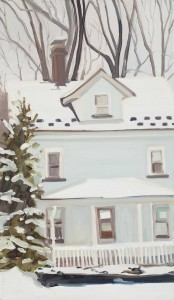
Snow & Blue Light
Oil on Panel, 20” X 11 3/4”, 2014 image courtesy of the artist and the George Billis Gallery
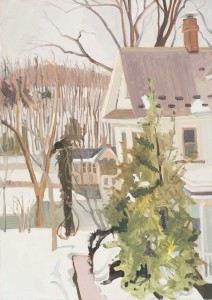
Snow & Pink Path
Oil on Panel, 20” X 14”, 2014 image courtesy of the artist and the George Billis Gallery
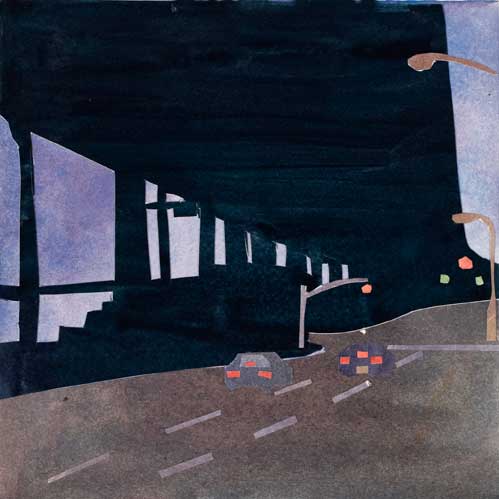
Night Under Expressway, 2007, Watercolor and Collage, 8” x 8”
LG: How much does your watercolors, collage and oil paintings inform each other? Do you make them concurrently or go through periods of each?
Elizabeth O’Reilly: I generally go through periods of oil, watercolor and collage. Oil is the most natural medium for me to pick up. I teach watercolor a lot and so I will often work more in that medium if that’s what I’m teaching. Watercolor is the hardest of the three as it takes more warm up time. Collage is more of a winter project, but when I get into it I get totally engrossed. Oil is what I take on my painting trips. The three mediums certainly inform one another. I think my oil paint is thin, and I use the transparency of the white board underneath, which is really a watercolor concept. Watercolor is a very unforgiving medium and it has taught me to be decisive and leave things alone. In graduate school John Walked used to say “Don’t approximate. Think about what you want to put down and leave it there” I’ve always found that very helpful. Working in collage has helped me to pare down my shapes even more. The black houses I painted in Maryland are a prime example of that. I’m really not putting in detail or much tonal work.
LG: Can you explain how you go about making your watercolor collages? Are they based from previous studies from life, photos and/or memory and invention – or do you mix it up?
Elizabeth O’Reilly: I wanted to make collages for a long time. It’s a really great studio project for a plein air painter in winter. I made two very simple small square collages first and I pinned them on the wall in my studio, and I looked at them for a long time. And a couple of years later I started again. I used my own oil paintings of the Gowanus as subject matter, printing out copies of paintings from slides, though the collages are much smaller.
The nature of collage forces a lot of changes because of cutting out the shapes instead of painting them. The person whose work I looked at a lot was Alex Katz. I’d seen a couple of his early collages and then a friend sent me the catalog of his collage show at Colby College. The reproductions are life-size…very tiny, and very simple. His collages are of landscape but often with figures in them. They were a way in to the process for me. I combine watercolor with my collage in two ways. Very often I will make a graded wash with transparent colors as my base, particularly if there is sky and water. I carefully make a tracing from the print out of the painting, and then I reproduce the shapes and colors, and paste them down on watercolor paper, which has the graded wash.
I really simplify and flatten the shapes. The graded wash creates the illusion of naturalistic space, but the shapes themselves are just flat colors. I love the quality of the color one can make with watercolor, as it really sparkles. By cutting out the shapes I need when the paint has already been applied I eliminate of one the most maddening characteristics of Watercolor: the edge problem. I use Jade adhesive which I buy at Talas, a store in Williamsburg. It’s archival. I add a little water and use an old oil bristle brush. It’s like a jig-saw. The process is slow and meditative, totally different from the immediacy of the plein air experience.
I generally start with the larger shapes and move to the smaller ones, and often move from the distant shapes to the foreground. Watercolor has a jewel-like quality and I use a utility knife to cut rather than a scissors, as I like the quality of the cut from the knife better, the straight edges it makes and also the lack of control the blade gives. It’s really fun to re-create reflections in water with cut out pieces of paper. The collages take a long time to make but I really enjoy making them. Sometimes they become really complex and other times they are really simple.
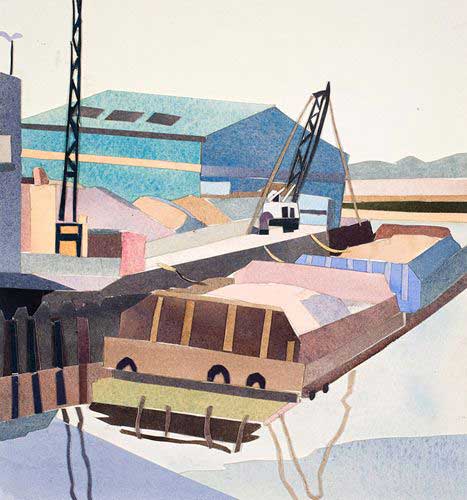
Barges, 2009, Watercolor and Collage, 8¼” x 7¾”
LG: The cut-out shapes are very hard edged and flat however your collages often drawn with a naturalistic space, the perspective looks observed as if you were painting directly in response to an observed scene. You don’t seem to distort or flatten the picture plane like you might expect to see in some other types of landscape collage. Why is that?
Elizabeth O’Reilly: The cut out shapes are hard edged because I focus on shapes and flatten and simplify the color. The graded wash, the gradual diminution of the size of the shapes, and atmospheric perspective create the illusion of deep space. The perspective looks observed because my own paintings that were made on site are the source material. I think I am still involved in creating naturalistic space so they still feel like observed space. It’s the objects that I flatten.
LG: Have you seen the big MOMA Matisse Cutouts show? What are your thoughts? Who are some great contemporary painters making collages that you admire?
Elizabeth O’Reilly: I’ve seen the Matisse Cutouts show three times. I loved it. It’s great to see them in person to see the scale of some of them that I expect to be smaller, like “The Snail”, “The Swimming Pool” is also wonderful. When I went early in the morning, my trick was to start at the end of the show and work my way back and that way I very often had rooms to myself. I ran a collage workshop out of my studio recently, and on the Friday night I met the students at Matisse’s cutouts. It’s good for the students to see how Matisse drew with a scissors, and how he approached the shape of the figure in such a minimal way. On the Saturday morning I had a model for the students to draw gesture poses, figure in motion and the clothed model. In the afternoon they chose a drawing from the morning session and used it to make a collage. On the Sunday the students worked on a project of their own. Some students brought in a landscape they wanted to translate into collage, and another wanted to work on a series of self-portraits in collage using foil. We looked at various artists’ work for ideas on how to proceed.
I love Sharon Etgar’s collages. She shows at Davis and Langdale.
Mark Strand has beautiful collages too. He’ just passed away recently. And of course Alex Katz’ collages from the 50’s. They are landscape and still life, and gave me a way in to the process. I really responded to John Heartfield when I was in graduate school. He was a pioneer of modern photomontage. And of course Romaire Beardon.
2011 Video about Swarthmore College’s List Gallery exhibition of five collage artists including Elizabeth O’Reilly and Ken Kewley, Chie Fueki, Njideka Akunyili, and Arden Bendler Browning. Andrea Packard, Artist and List Gallery’s Curator, narrates this film and discusses insights into how these artists use collage in very different ways to explore space, color, and representation. (discussion of Elizabeth O’Reilly starts at 7:28)
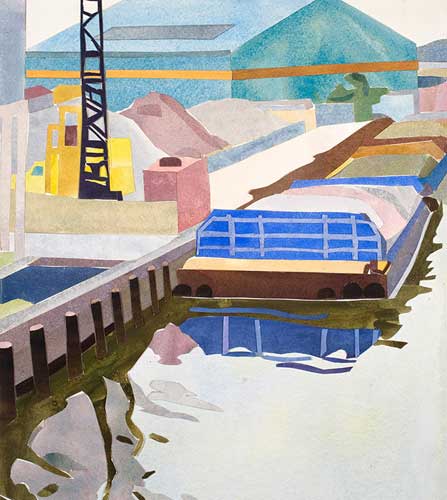
Barges at Hamilton Ave, 2009, Watercolor and Collage, 13″ x 11¾”
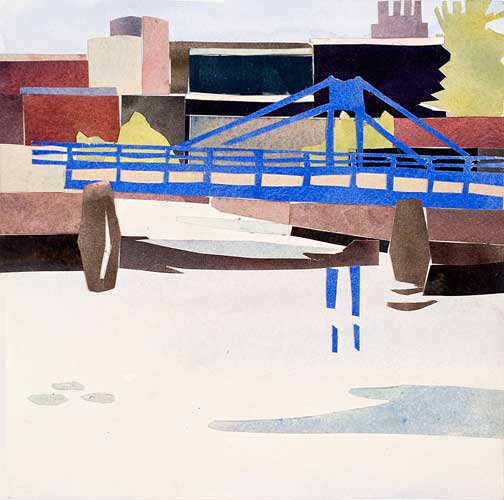
Blue Bridge #2, 2007, Watercolor and Collage, 8″ x 8″
LG: You are so lucky to be able to paint the Gowanus Canal area of Brooklyn, NY. It appears to be a visual treasure trove of painting motifs and an important part of your subject matter over the years. The great variety of shapes, patterns and colors in the industrial waterfront are perfect for the raw material in which to explore compositional possibilities. What has keep you painting here for so many years?
Elizabeth O’Reilly: My studio is right on the Union Street Bridge, and my windows overlook The Carroll Street Bridge. The other bridges that cross the canal are within walking distance of my studio. I’ve been in that building for 23 years now. At first I didn’t think of the city as a motif, but I painted the alleyway behind the building which has a bridge connecting one building to another. It has some broken windows which initially caught my eye. Lois and Arthur Kvarnstrom came to paint with me a couple of times and we painted in the vicinity of the studio, but then Diana Horowitz and I got together and we painted a lot over the years over the entire area. For several years, Arthur, Diana and I would paint together most days. Diana would often choose the spot and we would each show up when we could. It was terrific. It’s very motivating to know there’s another artist there already painting. Arthur would show up at 5 or 6AM, and Diana and I would show up later. It was a most productive time period for me. I’m not far from Red Hook which was a place I used to paint a lot also. It has the same kind of abandoned buildings, but like the Gowanus a lot of what was intriguing to an artist is now gentrified and changed. Even the Gowanus canal itself has lost a lot of what I loved to paint, as Whole Foods came in, and the beautiful red rock crusher is gone. The Hamilton Avenue bridge used to be a stunning blue, but now it’s a nondescript beige.
LG: How much does the place make a good subject for painting as opposed to the painter bringing the subject herself? Is there something intrinsic in a place, perhaps its history or mood that goes beyond just a visual attraction to create emotional connections that might give the attentive artist a greater connection? Or would you say the best painting spots are picked less from the specifics of the place and much more from painter’s personality and interest in some particular aspect of visual investigation?
Elizabeth O’Reilly: That’s an interesting question. Painting the landscape requires an urgency that painting in the studio does not. I find it easier to get started when I’m outside and I know the light is changing and the weather and so forth. Those practical things are good motivators for me. When I started out I looked for a new spot each time, but the longer I paint the more I go back to the same places over and over. And I find even if I go to another country, and even places like Ireland which are so scenic I find myself drawn to the discarded place. There is beauty in the rundown, and there is a poignancy to it that I am attracted to. My childhood had a lot of abandonment and so possibly without even being aware of the impact of that was that I found myself choosing abandoned houses and canals and bridges. There possibly was some identification on my part. That said I also paint in Ireland and enjoy the beaches and coastline. I used to go to the Ballinglen foundation for years. I was born in a very remote area in the most South Westerly part of Ireland by Mizen Head, and my family still goes there. That’s a recurring theme. I also like to paint the snow, though I’m not as hardy as I used to be. I used to go out to the Delaware Water Gap with Lois no matter how cold it was, and quite honestly the physical limitations forced us to work fast and to be very decisive.

White Foam, Coast Road, County Clare, 2001, Oil on Panel, 18″ x 14″
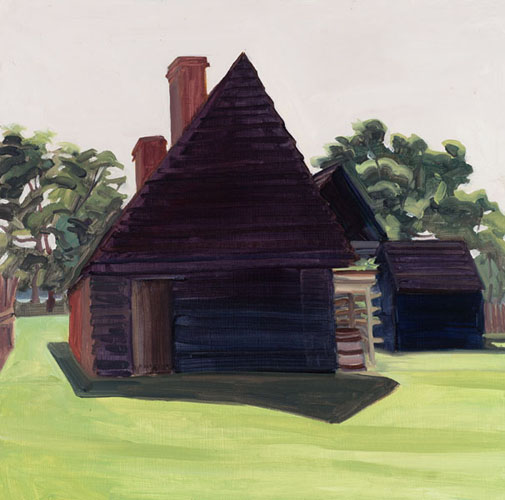
Black House and Shadow, oil on panel, 11″ x 19″, 2012. Courtesy of George Billis Gallery
LG: What does getting a sense of place in a painting mean to you?
Elizabeth O’Reilly: I think getting a sense of place just happens when you paint in the same spots over and over. Like the Hortense portraits with familiarity there is room for mood to come into the work. I painted in St Mary’s City in Maryland about two years ago, and it was very productive. The houses were rebuilt just as they were originally, and I believe it’s the second oldest colony in the US. I painted those houses from every angle and in every light. Often by the end of the day I knew exactly what I wanted to paint the next day, so I would quickly lay it out on my board so that the composition was all figured out. It really gives a sense of place if one can make many paintings in the same locale. They feed and inform each other.
LG: You’ve talked about your need to work fast and decisive and how Lois Dodd also worked in that way, very decisive. You also mentioned John Walker saying putting something down and just leaving it. I was hoping you might expand on this a little on why being decisive like that is important in your work as well as what about so many other painters who work with an opposite approach, who constantly revise and fuss over everything, do you find their work less interesting?
Elizabeth O’Reilly: That’s how I keep it fresh, and I also feel that the decision I make one day is different to a decision I’ll make another day, where that would become another painting. It’s a whole other thing. I don’t think my work gets better by laboring over it but of course I don’t think this means that this is the only way to work. I find this works better for me. It’s not that I don’t sometimes make a correction on a painting.
I remember doing a long narrow painting by this place in Brooklyn where the subway’s elevated, I had the painting for ages and then I realized I actually don’t like blue skies. They have a way of pinning this down as a landscape, somehow there’s not a way in. After ages, I thought to myself, I know I just don’t want all that blue sky. So, being that it was painted on a board I sanded out the sky and I totally repainted it in a color that wasn’t what I saw that day but it was a much better painting. So, once in awhile I can improve on something if I redo but for the most part I feel that’s where I was that day, I trust my responses on that day 99% of the time.
LG: Your freshness is admirable and fantastic as well as the many other painters painting decisively and who don’t tend to revise much later, like Lois Dodd. However, do you feel this approach could also lead to having a greater percentage of the paintings not working out?
Elizabeth O’Reilly: I think that’s normal, I remember a teacher at the Art Students League years ago, she said “Out of the 10 paintings that you make maybe three of them will be like ‘Wow! Did I make those?’ and then another four will be like ‘Ok, they’re passable’ and then that three will be dogs…That’s interesting but I think that’s fine. You get lucky and sometimes it’s like you get ahead of yourself and something new happens and it’s ‘Wow, I made that’ but you can’t rely on that all the time. I also feel like whatever works for each person is ok and this is important for teaching. We are all different and there is no one way to do it. There is room for however, whatever, fits us as individuals. If it takes ages and you rework it that’s just who you are. That’s not how I work but there is no right or wrong.
LG: I remember hearing some art students admiring the freshness and bravura brushstrokes of John Singer Sargent in many his oil paintings. I once had a teacher who said what you see in Sargent’s painting is last brushstroke not the first. That his freshness didn’t always come right off his brush on the first shot, he arrived at the freshness by scraping off all that didn’t work beforehand.
Elizabeth O’Reilly: Have you seen his watercolors? There was a recent show of his watercolors at the Brooklyn Museum. Oh my God they were stunning. You know they were on the spot, there’s no room there to redo.
LG: He has incredible sensitivity and facility with watercolor that is on a genius level. His oil painting, drawing and watercolors must all have influenced each other a great deal. That makes me think how your practise of mixing it up between the watercolor, collage and the oils must feed off each other and help them find the perfect one-shot notes more readily.
Elizabeth O’Reilly: Exactly, They really do, I am concerned with simplification and I do think it’s all abstraction because it’s just a rectangle and you’re trying to make this an interesting arrangement. To make people think this is space.
LG: In the paintings you did more recently in Maryland, the Saint Mary’s City paintings. These painting to me have a stronger, darker emotional presence than a lot of your other work. I’m curious is there some other level of meaning other than just the formal, visual response. Why did you chose this place and can you speak a little more about them?
Elizabeth O’Reilly: I painted there with Lois Dodd at St Mary’s College and next to it was this colony. I felt like oh my god, I really hit the jackpot with this one. I just know it was a really lucky find; when you see a place and you think there is so much material for me here. I imagine your mood comes into play but it’s all unconscious, it’s not like I went out looking for a colony with a lot of black houses, it just happened and I got excited. I got so much work done there, it was just a really lucky, good fit for me.
LG: I understand you are leading painting workshops there this winter. You and your students must be very serious and dedicated to be painting outside in the cold. Anything more you can tell us about your upcoming workshop?
Elizabeth O’Reilly: I have been running workshops out of my studio on the Gowanus for about five years now. The plein air workshops are in the spring and summer, and fall, but in the cold weather I run workshops indoors. I also run workshops out in East Marion in Long Island. Many of the students come back year after year. This winter I was able to take over a room in my studio space and I’ve been teaching watercolor classes once a week. I keep the numbers low so that students get a lot of attention. And I also run weekend workshops in Collage and Oil Painting for people who work Monday through Friday. The workshops are all listed on my website
I also teach at Rock Gardens Inn in Maine every summer, and at Bennington College through the MassArt program. My next goal is to run a workshop in Ireland. Students ask me all that time about doing that.
LG: You also teach painting the figure in watercolor. I enjoyed reading the October 2007 article in Artist Daily by Lynne Moss Perricelli about your watercolors and teaching. One thing you said in this article I found interesting was:
…“Being fixated on technique is a trap,” she emphasizes. “Other things are more important, such as color, value, and movement. Understanding those is what makes a painting work.” To that end O’Reilly is cautious about demonstrating, seeking to ensure that her students find their own way as artists. “I like to put up the paintings at the end of a class and see that each one is different. Each student is approaching the work in his or her own way and finding unique solutions. It’s no help to them to paint as I paint. Painting is really about problem solving.”
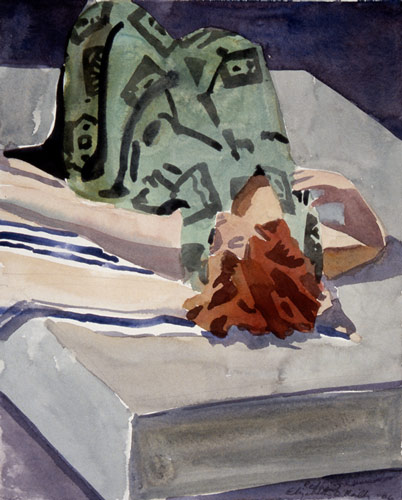
Red Hair, 2006, Watercolor, 8’ X 10”
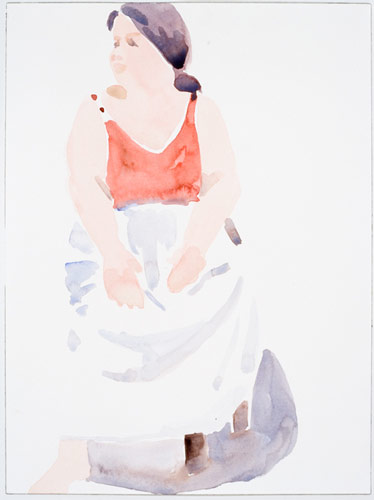
White Skirt, 2007, Watercolor, 14” X 10”
Elizabeth O’Reilly: Watercolor is the medium I find I have to warm up in so I used to go to Spring Studio in Manhattan with my watercolors to paint the figure. I love the clothed figure the most because I enjoy the color. I don’t sketch first, and that’s the fun part, just working from shape to shape, and often the poses are only a few minutes each. It’s a great way not to intellectualize, and to just make a ton of sketches. Students are confounded by the medium, but painting quick studies from the figure forces one to just work and work. There’s nothing better than brush mileage. The work just gets better from doing a lot of sketches. It’s helpful to know about what makes a composition work, positive/negative shapes, unity, variety, repetition, as well as color knowledge. In watercolor I rely a lot on transparent colors. If you really know the qualities of certain pigments it’s so easy to make exquisite grays instead of mud.
I prefer to demonstrate after the students have made their paintings rather than before. I find it limits and often paralyzes students as they somehow think that I have all the answers, and instead of finding their own path, they follow the same composition and choices that the teacher makes. I think it’s a disservice to students to turn them into clones. I always say that they get to take themselves home, and what they need is to find a way in, without me directing every step. Independence is what’s needed. I feel gratified if, at the end of a painting day, every painting looks different. People are all different and we bring our own experiences and knowledge to everything we do. It makes sense that the paintings should be different and not pale versions of what the teacher does. You can tell I feel very strongly about this. Final group critiques are very important also as the students learn as much from each other as they do from me, and when it’s not their own painting that’s being critiqued they can listen more intently. In the final group critiques I draw attention to the strengths of each student’s work. I try to be respectful and nurturing as a teacher as that’s the kind of teaching that helped me most.

Trees on Their Sides, 2005, Oil on Panel, 8 1/4″ x 32″

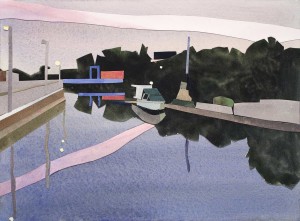
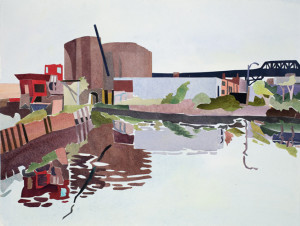
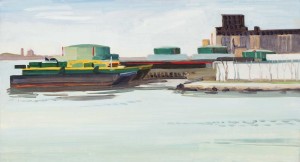
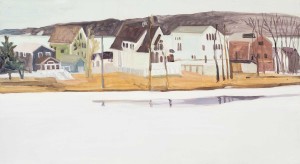
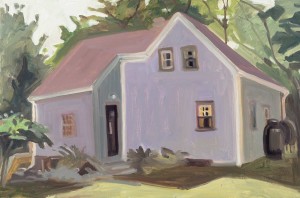
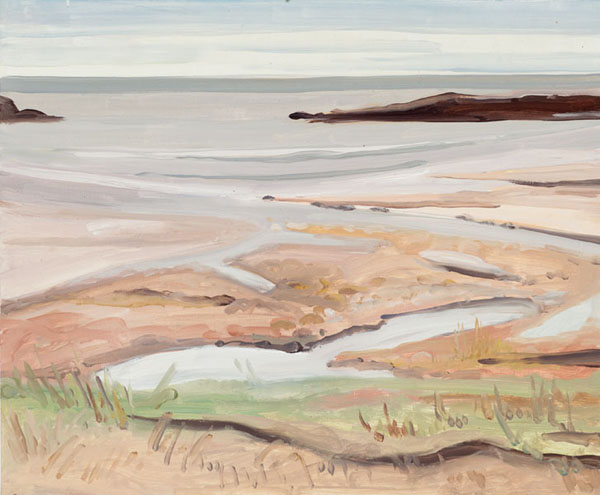

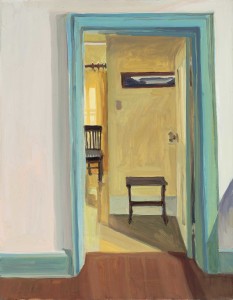
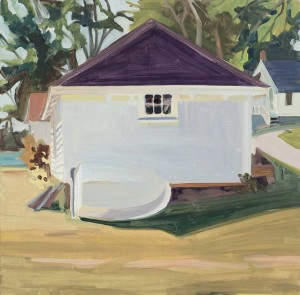




Newtown Creek is a knockout painting! Kudos, Elizabeth! And Larry . . .
This interview is profoundly interesting to me. I particularly love your paintings of buildings and facades, the light quality and sensitive keying of space, and I identify with your feeling of excitement when you see a place and you think ‘there is so much material for me here.’ I felt that way when I moved upstate to Catskill NY in 2005 after living for 30 years in New York City.
Alex Katz, Louisa Matthiasdottir and Lois Dodd, with their reductive treatment of form and clarity of light, have been life-long influences on my studio practice as well. I envy your years spent painting with Lois Dodd. And I admire your ability to reach out. This is very difficult for me and I have to push myself to do what I need to do to get the subject material I want for painting. I also admire your courage and participation in life. Your observation: ‘It’s amazing what can happen when you show your face. That’s a big life lesson for me,’ is so true.
Thank you Larry and Elizabeth for a wonderful interview.
Elizabeth..
A wonderful article..with succinct fresh paintings..
very nice to see.
Thanks so much,
Julie
I found this interview truly fascinating, I have known Elizabeth for quite a few years and learned more about her in this interview than I have in 7 years !She is an inspiration to all new artists, those who have art in their soul, in their hearts and to those who just dream it. I have been honored with her friendship as well as a recipient of some of her works, truly blessed. Her freshness and insight is astounding, keep painting Elizabeth !
Thank you, Elizabeth, for sharing yourself in this interview. It is done so well and thoughtfully. As a Brooklyn native, I feel that you have captured a place that time forgot and it is very moving.
Terrific interview Elizabeth. And so good to see your new work. Congratulations!
Solid work by Elizabeth. Great simplicity in my opinion. I am reminded of Fairfield Porter.
I live in Minneapolis and the subjects of my paintings for the past 15 years have been the North Shore of Lake Superior environs. Please visit my website. Melissa and Scott Bean (who studied with Lois Dodd a year or so ago)sent me your interview. I grew up in the SF Bay area and studied with Richard Diebenkorn and James Weeks. I am very well acquainted, mostly through reproductions, with the eastern painters you mention. I saw a Katz show here in the Twin Cities in 1972 that opened my mind about color especially. But I am now 77 yrs and have my sensibility completely formed as the combination of my knowledge and my inner spirit.
Your paintings are very fluid and beautiful.
James (Jim)
Really enjoyed reading this interview. Elizabeth O’Reilly’s sensitivity to her environment, whether man made or natural, informed by her own particular life experiences, is a main factor in making her work so evocative.
Elizabeth- So rare to see someone so articulate in words and painting. I feel honored to have been to see Matisse show with you. Hope to see more art with your insights soon.
xxGreta
Elizabeth,I finally got to read your interview today. Congratulations on all you have achieved and I look forward to what is yet to come.
So much fun to see your work and hear about your method. I took classes with you a long time ago. Michael Haviken was in same class. He has continued to paint, even out west I think.